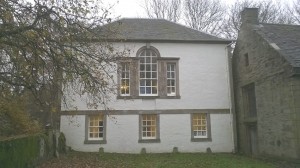‘Connected Collections’, Library of Innerpeffray, 29 November 2014
Last Saturday, I was at the wonderful Library of Innerpeffray, Scotland’s oldest lending library (founded ca. 1680) for ‘Connected Collections’, a workshop organised by Jennifer Barnes and Chris Murray of the University of Dundee. This was designed as a forum for academics, archivists, library and museum professionals, and students to discuss the promotion of creative collections at Scottish universities and work towards potential partnerships and research bids.
After my opening talk on ‘Widening Access to Creative Collections at Edinburgh University’, Neil Curtis (Head of Museums, Aberdeen) gave an historical account of collecting and cataloguing policies over the 18th and 19th centuries noting how changing curatorial approaches repurposed and recombined Aberdeen University’s collections, sometimes creating hybrid objects. He stressed too the role of Scottish universities as combined national institutions, rather than regional entities serving only their immediate area.
Karl Magee (University Archivist, University of Stirling) introduced the archive of Stirling-born film-maker Norman McLaren and discussed, in particular, the relationship forged between the University Archives and the Stirling Smith Art Gallery and Museum, culminating in the exhibition ‘A Dream of Stirling: Norman McLaren’s Scottish Dawn’.
John Izod (Communications, Media and Culture, Stirling University) told the fascinating tale of Lindsay Anderson’s documentary of Wham!’s 1985 China tour, the first visit to that country by a western pop group. Anderson’s radically different first version, rejected by the group’s management, is in Stirling University’s Lindsay Anderson Archive.
Julie Gardham (Senior Assistant Librarian, Special Collections, University of Glasgow) presented a number of innovative ways of promoting arts and humanities collections, including using archives as inspirational materials for creative writing workshops, pitching under-used and uncatalogued collections at potential researchers at evening receptions, and running a student blogathon, with prizes for the best and most liked posts for items on Special Collections and Archives material.
Gerard Carruthers (Francis Hutcheson Chair of Scottish Literature, University of Glasgow) argued that there was a need for a concerted effort to catalogue and explore 18th– and 19th-century poetry archives in Glasgow and the West of Scotland. This was material that had been neglected due to the prevailing misconception that Scottish poetry had descended into sentimental tartanry after Burns. He wished to see a project ‘Scottish Political Poetry and Song, 1832-1918’ researching material in newspapers and periodicals to create an alternative print cultural history.
Caroline Brown (Deputy Archivist, University of Dundee), discussed her university’s promotion of embedded archival teaching, including the award of a prize for the best piece of work using archival materials. She placed particular stress on oral history projects involving Dundee’s jute mills, the publisher D. C. Thomson, and patients and staff at a hospital for people with a learning disability.
Chris Murray (Dundee) discussed the use of archives in Comics Studies courses at Dundee University. These were largely created through building up close relationships with individual comic artists and publishers, many of whom regularly visited Dundee to give talks to the students. Archival materials were also used to inspire students to create their own comics. Dr Murray noted the difficulty in using some recent materials for teaching and research, due to donators’ concerns that materials might be uploaded to the internet.
Finally Brian Hoyle (English and Film Studies, Dundee) introduced Dundee University’s recently acquired archive of the Scottish novelist and screenwriter Alan Sharp, and discussed his interest in building an archive of unfilmed cinema scripts (of which there were many first-rate examples in the Sharp Archive).
The day ended with a round-table discussion which gave student delegates a chance to express their own views on the efforts of libraries, archives, and museums to engage with them. A common theme was a desire for easier and more uniform access to collections in institutions other than the student’s own. Archivists also expressed concerns that universities were no longer training students in the skills required (Latin, palaeography) to decipher archival materials.
The day provided an excellent opportunity for forging contacts between academics, library and archive professionals, and students working with creative collections. It was also an invaluable platform for library and archives staff to exchange ideas on outreach and widening participation. It is to be hoped that future ‘Connected Collections’ workshops will be organized to build on the relationships established at Innerpeffray.
Paul Barnaby, Archives Team, CRC

